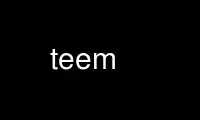
This is the command teem that can be run in the OnWorks free hosting provider using one of our multiple free online workstations such as Ubuntu Online, Fedora Online, Windows online emulator or MAC OS online emulator
PROGRAM:
NAME
teem - simple command-line tools which provide fast and easy access to the functionality
in the various libraries
DESCRIPTION
teem-affine: This uses air's AIR_AFFINE macro to print out the value which stands in the
same relationship with the interval [<minOut>, <maxOut>] as <value> has with the interval
[minIn, maxOut].
teem-deconv: Does deconvolution.
teem-airSanity:
teem-cubic:
teem-emap: Creates environment maps based on limn's "checker" normal quantization methods.
By taking into account camera parameters, this allows for both lights in both world and
view space. Solely out of laziness, the nrrd format is used for specifying the lights, but
not to worry: you can use a simple un-adorned text file, defining one light per line, with
7 values per light: 0/1 (world/view space), R G B color, and X Y Z position.
teem-gkms: Semi-Automatic Generation of Transfer Functions
teem-idx2pos: Converts from floating-point "index" to floating-point "position", given the
centering of the data (cell vs. node), the range of positions, and the number of intervals
into which position has been quantized.
teem-ilk: (I)mage (L)inear Trans(X-->K)forms. Applies linear (homogenous coordinate)
transforms to a given image, using the given kernel for resampling.
teem-miter: A simple but effective little volume renderer.
teem-mrender: A demonstration of hoover, gage, and nrrd measures. Uses hoover to cast rays
through a volume (scalar, vector, or tensor), gage to measure one of various quantities
along the rays, and a specified nrrd measure to reduce all the values along a ray down to
one scalar, which is saved in the output (double) image.
teem-ninspect: Quick way of seeing what's inside a 3D volume. A color image of three
axis-aligned projections is composed of histogram-equalized and quantized images of the
summation (red), variance (green), and maximum (blue) intensity projections. If volume is
orientation in RAS space, then a standard orientation is used for projections and
projections are upsampled (with box kernel) to have isotropic pixels.
teem-ninspect: Quick way of seeing what's inside a 3D volume. A color image of three
axis-aligned projections is composed of histogram-equalized and quantized images of the
summation (red), variance (green), and maximum (blue) intensity projections. If volume is
orientation in RAS space, then a standard orientation is used for projections and
projections are upsampled (with box kernel) to have isotropic pixels.
teem-nrrdSanity:
teem-overrgb: Composites an RGBA nrrd over a background color (or image), after doing
gamma correction, then quantizes to an 8-bit image. Actually, the input nrrd can have more
than 4 values per pixel, but only the first four are used. If the RGBA nrrd is floating
point, the values are taken at face value; if it is fixed point, the values interpreted as
having been quantized (so that 8-bit RGBA images will act as you expect). When compositing
with a background image, the given background image does not have to be the same size as
the input image; it will be resampled (with linear interpolation) to fit.
teem-pos2idx: Converts from floating-point "position" to floating-point "index", given the
centering of the data (cell vs. node), the range of positions, and the number of intervals
into which position has been quantized.
teem-pprobe: Uses gageProbe() to query scalar or vector volumes at a single probe
location.
teem-qbert: Generates volume datasets friendly to hardware-based volume renderers. The
main value of this is a means of combining the functions of resampling a dataset to a
particular size, measuring first (and optionally second) derivatives, and doing some
semi-intelligent quantization of the derivative values down to 8-bits (if quantization is
desired). The various up and down sampling, as well as the the VGH measurements, can be
done with various nrrd kernels. Also, histogram-equalized VG and VH scatterplots can be
generated at a specified resolution.
teem-talkweb: Generates HTML pages from slide images and text. This program takes multiple
inputs: a template for the table of contents that will become "index.html" ("-i"), a
template for the pages generated for each slide e.g. "slide000.html" ("-t"), and a script
text file that contains all the information that will go into the slide pages. The format
of this file is:
- Separator line indicating slide transitions, e.g. "-------------"
- Title of first slide (one line)
- Filename for image to put on first slide (one line)
- Body of HTML text to put with the slide image (multiple lines)
- Separator followed by information for the second slide, and so forth. Textual
subtitutions are performed in the template files, according to the replacement tags ("-r",
see below). Within the slide pages, navigation arrows are based on remaining command-line
options.
teem-tend: Diffusion Tensor Processing and Analysis
teem-undos undos: Converts from DOS text files to normal (converting LF-CR pairs to just
CR), or, with the "-r" option, convert back to DOS, for whatever sick and twisted reason
you'd have to do that. Can also handle legacy MAC text files (only LF). Unlike the simple
sed or perl scripts for this purpose, this program is careful to be idempotent. Also, this
makes an effort to not meddle with binary files (on which this may be mistakenly invoked).
A message is printed to stderr for all the files actually modified.
teem-ungantry: Gantry tilt be gone! This program is actually of limited utility: it can
only change the tilt by shearing with the X and Z axis fixed, by some angle "around" the X
axis, assuming that (X,Y,Z) is a right-handed frame.
teem-unu: Utah Nrrd Utilities command-line interface
teem-vprobe: Shows off the functionality of the gage library. Uses gageProbe() to query
various kinds of volumes to learn various measured or derived quantities. Can set
environment variable TEEM_VPROBE_HACK_ZI to limit probing to a single z slice.
Use teem online using onworks.net services
